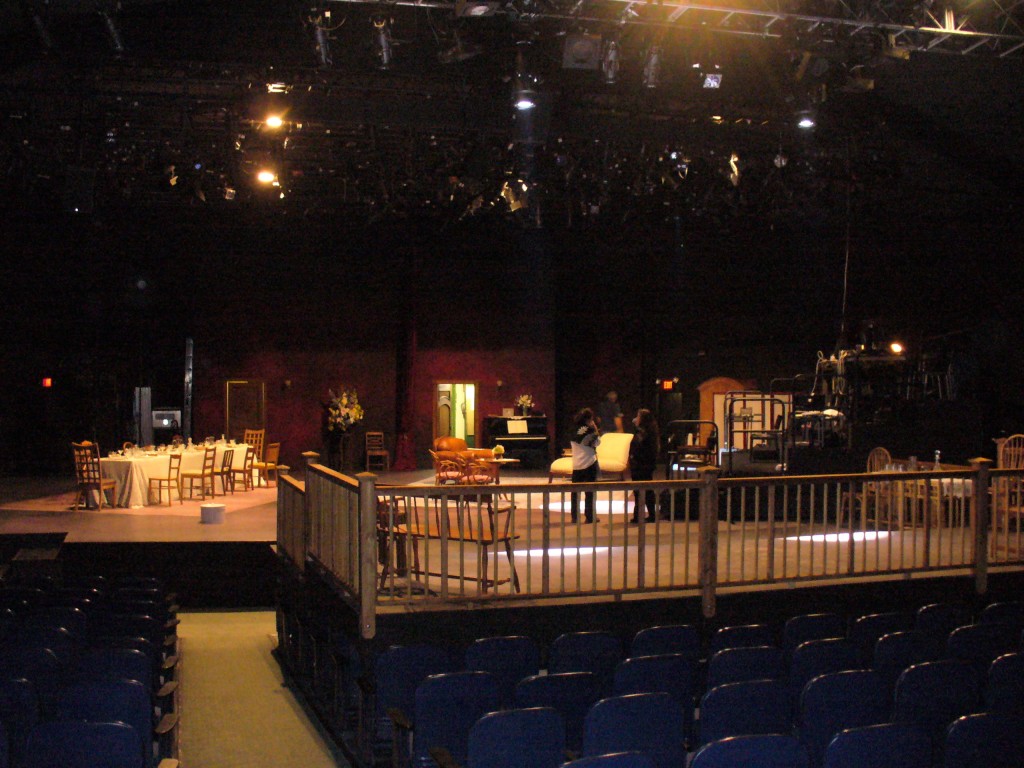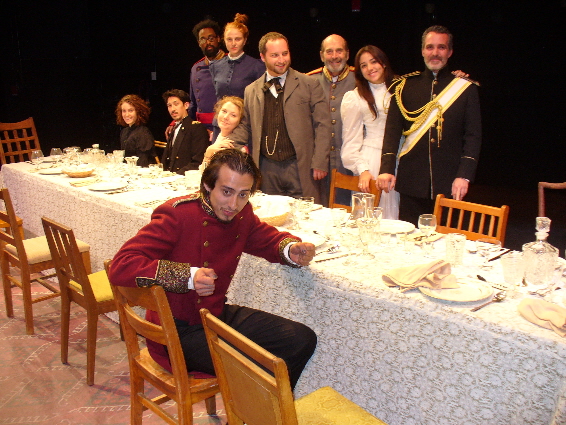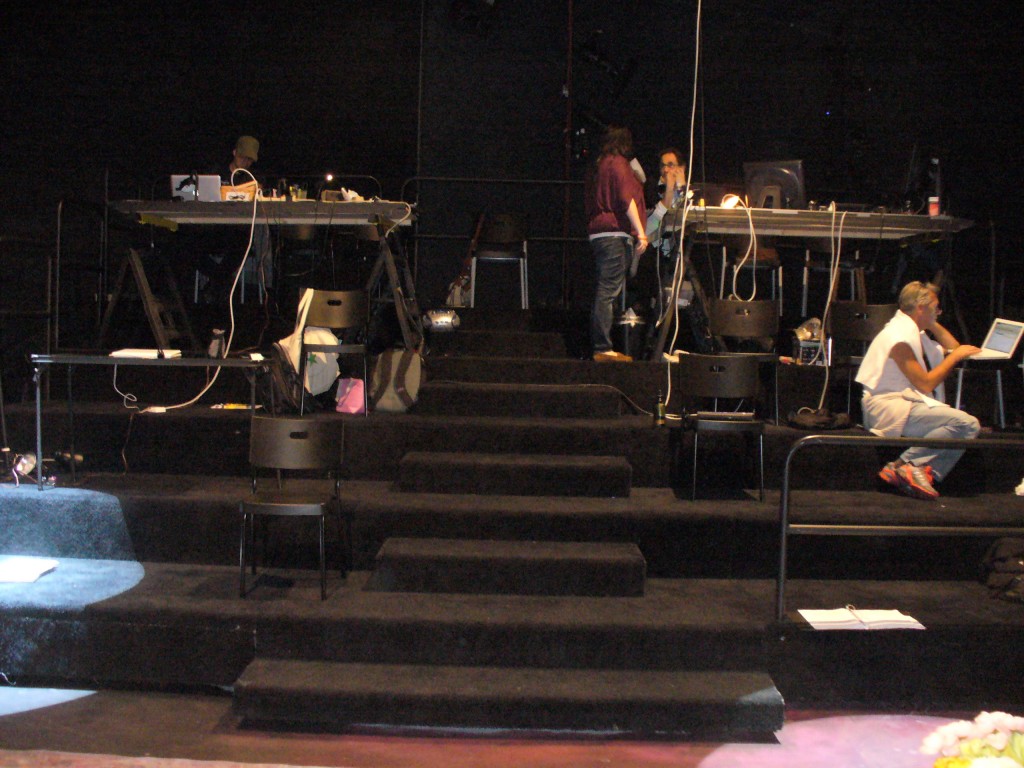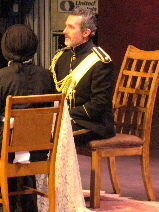
MTC’s set spreads across the stage and spills into the auditorium; the audience sits in the riser on the left / Staff Photo
By Bill Hirschman
What will likely have people talking as they walk into the Miami Theater Center this weekend for its new adaptation of Chekhov’s Three Sisters is where they’ll sit: a black riser taking up a third of the stage itself.
What will likely result in squeals of surprise is how, between scenes in the four-act play, the riser will pivot with the audience still in their seats to face a different part of the set – in one case, a huge platform thrust over the first few rows of the auditorium.
But the rotating seating, which limits attendance to 49 patrons each night, is only the most high-profile aspect of a ground-breaking production. It marks the transition of The PlayGround Theatre in Miami Shores known for its children’s productions into the Miami Theater Center whose mission has been expanded to present adult fare.
It also marks the first time in recent memory that any mainstream professional theater has tackled a full production of the plays of Russian genius Anton Chekhov, let alone his masterwork about a privileged family struggling to seek meaning in their lives while atrophying in a stultifying provincial town.
MTC’s staff has dove into the challenge with its own translation and adaptation of the 1900 script and invested benchmark resources, starting with a 17-member cast.
The company created in 2004 has specialized in highly stylized productions designed to spellbind young audiences. Well-funded by donors and grants, the troupe has created a national reputation for its imaginative staging, its lush production values and its philosophy that children’s theater should not condescend to its audience. Much of its season is devoted to busing in tens of thousands of Miami-Dade schoolchildren, many of whom are seeing theater for the first time.
Employing an aesthetic echoing European and avant garde artists, their production style differs from almost every other theater in the state. A highly collaborative group headed by Miami native Stephanie Ansin and Venezuelan designer Fernando Calzadilla spend months developing a new work from script to original music. They invest unprecedented amounts of time and money in a painstaking hand-made process exemplified by an 11-week rehearsal period that focuses on graceful movement as well as speaking the text.
Ansin and her staff decided this year to apply that vision to their long-held dream of mounting adult productions. MTC is doing so with a characteristic flourish that recognizes few restraints on the artistic impulses.
To begin with, their version is far less bleak and stilted than many productions. They are also determined to make the century-old play vital and relevant to modern audiences.
“Three Sisters has been usually read as a pessimistic play, as a tragedy,” Calzadilla said during a rehearsal break on Halloween. Instead, “we read it as the sisters taking action, wanting to move to a better world. They want a better life for the people around them. They want to create happiness and they adapt. I think that’s a very important message today.”
The new script also strives to make modern audiences understand the sisters’ plight, he said. “When the sisters keep repeating, ‘Let’s go to Moscow; let’s go to Moscow,’ and they are three wealthy women, you may ask yourself, well, why don’t they just go? What’s holding them down? Well, in that time, a woman could not get a passport to travel 20 miles unless it was signed by a father or a husband.”
More important, “we wanted a more visceral feeling, the saliva and the blood, that in Chekhov is usually removed,” Calzadilla said. “In most Chekhov productions, there is a style and an elegance. We wanted something more raw, more passion.”
Toward that end, the creative staff wanted to erase the traditional boundaries and barriers between the artifice of theater and the audience. Thus, the idea of the rotating riser, the thrust into the normal seating area and other physical staging choices. “We want to invite people to our house… bring them into the space so they can see where we work,” Calzadilla said. “There’s no masking (of the wings), no hidden space except for the dressing rooms. But other than that, you see everything. You can see the lights. Everything is mixed and bleeding one onto the other.”
Ansin has what she calls “connect moments” in which actors break out of the action, come into a bubble of light close to the riser and address the audience – akin to pop-up caption in a video. “So that’s a bridge between the fiction we’re creating and the fact of the audience in the room. We’re not ignoring that we’re talking to you,” Ansin said.
Calzadilla went further. “The George Washington Bridge isn’t in New York and it isn’t in New Jersey; it’s in both at the same time. So the connect moment is the moment when the actor is not in the show and is in the show at the same time. And it’s still the actor and it’s still the character, but it’s with the audience. There is a lot of this in the space. The theater melts into the set and the set melts into the theater.”
The bridge metaphor is not an accident but another piece of the vision that seeks to make the play timeless and transcendently relevant. “This is not a cast trying to make a museum piece,” Ansin said, “It’s a bridge between Moscow 1901 and Miami Shores 2012.” Although the cast has studied Russian culture, it is an inescapably multi-ethnic group, some of whom have adopted the courtly personas of Chekhov’s characters, some exhibiting a more contemporary vibe.
MTC’s path to Three Sisters stretches out years. “It’s been in the shadows for a long time,” Ansin said. As a student actress in New York, “It was the play that taught me as an actor how it felt for my words to come out of my body. It was that play when I first felt that huge eureka moment.”
The idea gelled when Ansin and Calzadilla were producing their original children’s play The Red Thread in 2011. “There was a moment when we were doing an audition when we had three women on the bare stage and suddenly there was this sense of seeing a moment of Three Sisters,” Ansin said. “So when it became time to launch Miami Theater Center, it was the only thing we thought of because it had been lurking for so long.”
Their first need was a fresh script. None matched the vision that Ansin and Calzadilla had, especially an edition that would be two hours long not the usual four. So in October 2011, the theater commissioned a literal Russian translation from Ansin’s sister-in-law from Belarus, Tatsiana Yarashevich.
In January, the duo compared their new text line by line with translations and adaptations from four other playwrights include Sarah Rule (Clean House) and Paul Schmidt who did a version for the avant garde off-Broadway Wooster Group. They even examined specific Russian phrases through Google’s translation site.
Then Ansin and Calzadilla synthesized their own version, cutting heavily and using their own syntax and vocabulary. The guiding key was to create a fresh vision of an energized, even uplifting take on a tale that can seem tragic and moribund. While each partner participated in all aspects, Artistic Director Ansin focused on the script and Resident Artist Calzadilla concentrated on evolving the visual images.
The logistics were daunting as the summer approached. Knowing that each actor in the large cast would have three or more costumes, the creative staff knew it could not build most of the outfits from scratch in time, nor afford such a huge expense. Calzadilla flew out to the costume shops of Oregon Shakespeare Festival and American Conservatory Theater of San Francisco where he chose 80 percent of the costumes from their rental stock. In keeping with the timeless feel that Calzadilla sought, the costumes are not all Russian nor are they even from the same period. A similar aesthetic applied to props and furniture. Each was hand-picked to communicate a sense of having been used for decades, but they were scavenged from “every thrift shop on Dixie Highway,” said Elaiza Irizarry, executive director and producer. None of the stemware matches, she noted.
The producers had to solve unexpected challenges. With such a large cast and a narrow hallway for a dressing room, the company was forced to rent a building next door to house the male actors. It also stores the overflow of props and equipment including a dishwasher to clean the many goblets and plates dirtied during the banquet scene.
Early on, Ansin and Calzadilla opted to put the entire audience on the stage, an intimate approach that dovetailed happily with their expectation that Chekhov was not going to be a huge commercial box office draw.
“And then we thought, if we’re on the stage, we’ll have to move the audience to change the set,” Ansin said. “And then we thought, well, let’s not move their chairs; let’s move the whole unit and give the audience a different perspective (in each act).”
As the ideas evolved, Irizarry suggested building the massive platform thrusting into the auditorium to serve as the Act Four garden scene. Simultaneously, Ansin and Calzafilla led a cadre of artists they had worked with before, including choreographer Octavio Campos. Sound designer Luciano Stazzone pressed the eclectic notion by composing in musical styles ranging from Russian Orthodox folk music to contemporary tunes.
Casting began in September. PlayGround has had trouble attracting local actors to auditions because of the rigorous training demands of the company’s approach to rehearsal. But this time, the prospect of performing Chekhov attracted well-known veterans Wayne LeGette and Howard Elfman as well as PlayGround stalwarts like Steve Gladstone, Troy Davidson and Linda Bernhard. “This is the first play we haven’t had to go to New York to have auditions,” Ansin said.
Chekhov is rarely done in Florida theaters, in part, because his work poses a tough acting challenge. LeGette, playing the linchpin part of Vershinin, explained, “Chekhov really goes out of his way not to say what he means. Every play that we do requires preparation and understanding and intellectual knowledge of what you’re talking about and subtext. But Chekhov is subtext on crack…. So much of the work is done inside the words.”
Once casting was finished, the 11 weeks of rehearsal began. The MTC process of extensive warm-ups, trust building exercises, improvisation and theater games is a far cry from the slam-bang process familiar to most South Florida actors.
“It’s like going back to school,” LeGette said during an interview at the MTC’s Sandbox black box theater next door. “The first thing after a read-through of each act, we did acting exercises, intense physical work. It’s been so long since I’ve done that. It took 26 years for me to get back here. You have to just embrace it.”
He added, “When you’re used to doing 2 ½ weeks of rehearsal… you do your warm-up in the car or you do your warm-up at home before you get here. There’s just no time. Any preparation that you have to do for a scene, you have to do it the night before. There’s little time to play. Here, well, I mean, come on: This is called the Playground and the Sandbox. That’s what you’re all about. So what an incredible gift we’ve been given, us old pros, to go back to the basics.”
 Besides giving the men the time to grow beards, the long gestation also created a bond among the cast which includes Yevgeniya Kats as Olga, Emily Batsford as Masha, Diana Garle as Irina and Nikki Lowe as Natasha.
Besides giving the men the time to grow beards, the long gestation also created a bond among the cast which includes Yevgeniya Kats as Olga, Emily Batsford as Masha, Diana Garle as Irina and Nikki Lowe as Natasha.
The time isn’t an indulgence. The team alters a great deal on the ground during rehearsals and on stage. During technical rehearsals on Halloween, they spent a half-hour with the entire cast in costume, fine-tuning the timing of 30 seconds of stage time. Several tasks chugged along simultaneously: setting light levels, trying out sound effects, changing the timing of entrances, trying out new blocking, the Hispanic actress playing Irina rolling around the tongue twisting Russian names under her breath.
So, when a maid welcomes the audience in the lobby this week and ushers them en masse into their seats, Ansin and Calzadilla are hoping that the patrons are also being welcomed into a new era for the company.
Three Sisters plays Nov. 14-Dec. 22 at Miami Theater Center (the former PlayGround Theatre), 9806 NE 2nd Ave., Miami Shores. Performances during the week for high school students. For adults, 8 p.m. Friday and Saturday; 2 p.m. Sundays. No performances Nov. 23-25. Tickets $35. Opening night tickets are $150 with a caviar-and-vodka party with the cast and creative team. For information, call (305) 751-9550 or visit www.mtcmiami.org/event/three-sisters/#more-13472. Everyone is seated at one time; no late seating.
To see videos about the new production, click here.
To read an extensive profile of The PlayGround Theatre in American Theatre magazine, click here.












 A PaperStreet Web Design
A PaperStreet Web Design

Pingback: MTC’s Inventive Staging Of Chekhov’s Three Sisters Is By Turns Brilliant And Bothersome | Florida Theater On Stage
Pingback: MTC’s Inventive Staging Of Chekhov’s Three Sisters Is By Turns Brilliant And Bothersome